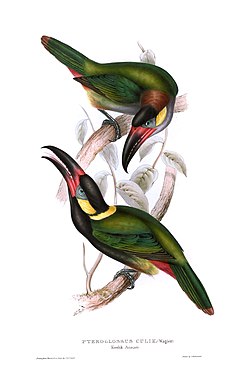| Guianan toucanet | |
|---|---|
 | |
| Male at Dallas World Aquarium, USA | |
| Scientific classification | |
| Kingdom: | Animalia |
| Phylum: | Chordata |
| Class: | Aves |
| Order: | Piciformes |
| Family: | Ramphastidae |
| Genus: | Selenidera |
| Species: | S. piperivora |
| Binomial name | |
| Selenidera piperivora (Linnaeus, 1758) | |
 | |
| Synonyms | |
| |
The Guianan toucanet, or Guyana toucanet (Selenidera piperivora) is a near-passerine bird in the toucan family Ramphastidae. [2] It is found in Brazil, French Guiana, Guyana, Suriname, and Venezuela. [3]





